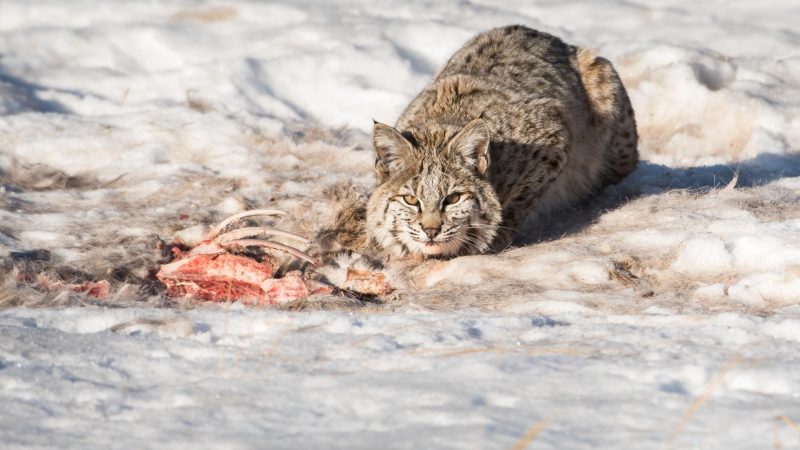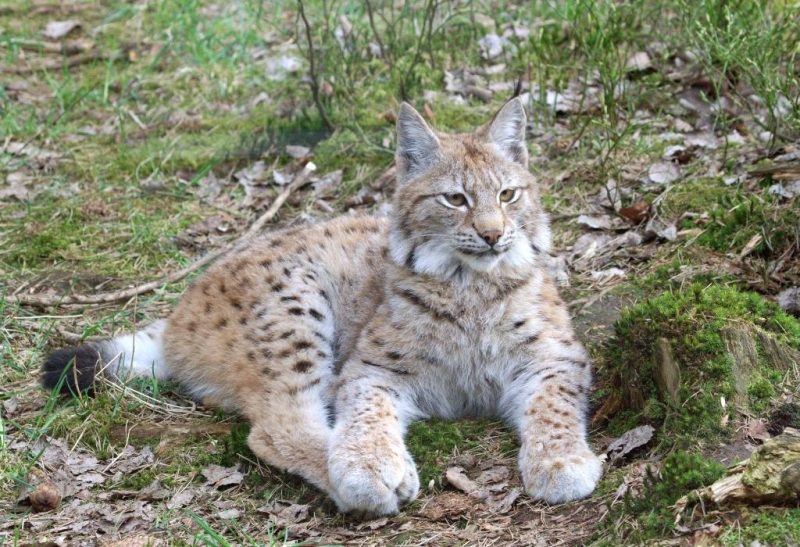Although some bobcats live at the city’s edge, they can be rarely seen because they’re nocturnal. These animals can see six times better than humans in the dim. Thus, they start hunting for food when the sun is down.
Bobcats are carnivorous, and they’re satisfied with birds and small mammals. After digesting their food, what happens next? You’ll find out in this article.
What does bobcat poop look like? Since bobcat poop is tubular with a brown or black hue, it’s sometimes mistaken as dog poop. But the bobcat’s poop is generally smooth, and it can be in one length or segmented into narrow portions. It usually appears blunt with one pointed end.
Since a bobcat is a carnivore, there’s not much variety in its diet. As mentioned, its poop has a smooth consistency. Is it possible that some things like grass and bones appear with the poop?
It’s important to know as it can help you determine if a bobcat is hanging around your yard.
Table of Contents
What Do Bobcats Eat?

Bobcats mainly eat birds and small mammals. They can easily snatch low-flying birds by leaping. The mammals that they usually capture are mice, rabbits, woodrats, and ground squirrels. Bobcats can also prey on animals that are bigger than them.
They occasionally feed on deer, but they eat the carrion most of the time. Unexpectedly, they can prey on goats, sheep, and poultry. Fortunately, the bobcats can’t bring about massive damage to these domesticated animals.
Those that live in urban areas rummage garbage containers that they can open. They’re also attracted to the pet food that people leave outside.
Bobcats are also drawn to bird feeders as mice, one of their prey, always visit the area. These animals venture to the city because humans take care of their prey, such as rabbits and deer.
Pet cats and dogs are also a food source for bobcats. Thus, a good deal of food supply waits for them in urban places.
Bobcat Poop Identification

Not all bobcat scats are similar. Depending on what they eat, the consistency varies. Even a single bobcat can’t produce two scats that are identical.
Hence, comparison can be challenging, but you can find clues from the animal’s habitat, the location of the poop, with or without scrapes, and nearby tracks. Nonetheless, here are the general characteristics of the bobcat poop:
Texture
The texture of the bobcat poop is smooth and a bit shiny when wet. This is an implication that the animal is just nearby. Some bits of grass are occasionally found, but it’s rare to see fruit seeds that can cause rough texture.
Color
A bobcat poop is typically black or brown. Some parts can be yellowish at times as it all depends on the animal’s diet. When the scat hardens, the color becomes darker.
Length and Shape
The scat of bobcats is tubular and rope-like. It can be 3 to 9 inches long and 7/16 to 1 inch thick. The length of the scat is usually segmented, and the narrow portion is folded.
When all the edges of the segmented parts are blunt, they seem to appear like small sausages. But one end is sometimes pointed. At times, you can see a long string of scat with two or three small segments.
Smell
The description of the smell of the bobcat poop is limited. Its urine is the best basis as it usually pees before pooping. The smell can be compared with the cat’s urine. However, you can’t detect any smell if you find the scat after hours that the defecation took place. The poop smell disappears quickly.
Location
It’s common to see bobcats scat beside scratch piles where it marks their territory with urine. It can be found in the middle of the road or trail.
Contents
The contents of the bobcat poop will depend on its diet. Apart from smoothness, there can be prey’s fur or bones in it.
Can Bobcat Poop Spread Disease?

According to a study, the fecal material of bobcats is the cause of the spread of zoonotic parasites around residential areas. The pathogen circulation is encouraged by the high number of possible hosts. Hence, here are the diseases that can emerge from bobcat poop:
Bobcat Fever
Also termed Cytauxzoon Felis, bobcat fever is a tick-borne disease that is rampant in the cat community. The name is derived from bobcats because they’re the primary host.
The affected animal will initially experience sluggishness and loss of appetite. But its health significantly deteriorates once the infection enters its body.
After 20 days of having the fever, the cat will show some symptoms like jaundice, high temperature, enlarged liver and spleen, dehydration, pale mucous membranes, and respiratory distress.
Toxoplasmosis
This disease can be obtained in different ways, and one of them is through exposure to bobcat poop. To prevent getting infected with Toxoplasma gondii, you have to wash your hands thoroughly if ever you have contact with feces.
When the parasite has entered a body, one can feel common symptoms such as fatigue, flu, fever, swollen lymph nodes, head, and body aches. These things can go on for a month or more.
People who have weak immune systems will likely experience severe symptoms. Vision is reduced and blurry with red eyes. They’ll feel pain from staring at the bright light. Some individuals can have seizures or lung problems like pneumonia and tuberculosis.
When a pregnant woman is infected with this parasite, she can transfer it to the baby inside her womb. The symptoms observed among newborns are seizures, enlarged liver and spleen, the white part of the eyes, and skin turning yellowish.
It’s not only humans who can be infected with this disease. Cats, dogs, goats, pigs, rodents, and sheep are some animals that are affected by Toxoplasmosis.
Beaver Fever or Giardiasis
Bobcat poop has Giardia Lambia, which causes beaver fever or giardiasis. The person who had contact with it can have an intestine infection. However, the appearance of the symptoms is delayed. In a week or two, the person can feel fatigued, lose appetite, have nausea or vomiting, abdominal cramps, bloating, excessive gas, diarrhea, and weight loss.
Some domesticated animals like cats, dogs, goats, and sheep can also be affected by giardiasis.
Cryptosporidiosis
A protozoan parasite called Cryptosporidium causes this disease. It’s one of the parasites that are found in bobcat scat. Humans, pet dogs, and cats are likely to be infected. The usual symptoms are cramps, diarrhea, fever, nausea, and vomiting.
How Can You Tell the Difference Between a Bobcat Scat and a Coyote Scat?
A bobcat scat is a less ropy and more round than a coyote scat. It’s also dense and sharply segmented. When the scat you’re trying to identify has dried out, you have to step on it. The bobcat scat is hard but not compressed. On the other hand, coyote scat is softer.
What to Do if You Find Bobcat Scat in Your Locality?
If you’ve been seeing bobcat scat and its track around your neighborhood, you have to be careful. Bobcats stay away from humans and they don’t want to attack but still, you don’t want to take chances.
Some can have rabies then attack people, especially defenseless kids. As mentioned, their fecal material can spread diseases, so it’s another concern. If you find bobcat scat in your locality, follow these ways:
- Don’t allow your children to play outdoors when it’s dark.
- It’s best to make your pets stay indoors.
- Be extra careful if you have rabbits and chickens in your house.
- Seek help from wildlife organizations to get rid of these animals in your locality.
How Can You Tell if a Bobcat Is Around?

A bobcat can leave a kidney-shaped depression on the ground after it is repeatedly bedded in a certain area. Don’t confuse this depression with the round beds made by deer.
It makes scrapes and tracks to have its marks or cover up a scat. The scrape can be in a single direction or long that ends up in a pile.
You’ll also find scrapes that go in different directions and the pile is surrounded by numerous paw marks.
The tracks that a bobcat leaves behind are made of four toes and large heel pads. It has relatively larger heel pads than foxes and cats.
Frequently Asked Questions
Are Bobcats Aggressive?
Bobcats are rarely aggressive. When one of them attacks a person, it can cause rabies symptoms. If you try to get close to a bobcat, it will likely runoff. These animals are only attracted to your yard when they have something to prey on.
Are Bobcats Good Pets?
Bobcats are not good pets though the kitten is gentle and clingy to its owner. It’s like a cat, but it’s not because it can destroy furniture once it outgrew its surroundings.
A bobcat’s severe mood swing is the main problem that its owner would face. It’s docile and gentle, and the next minute, you’ll be surprised that it attacks new people that enter your house.
The gentle and docile will likely last for a month. When you’d attempt to discipline it because of its mischief, it becomes violent.
Do Bobcats Eat Dogs?
Bobcats can eat small dogs if you leave the latter alone outside.
Does Anything Eat a Bobcat?
Bobcat kittens can be eaten by large owls, foxes, and coyotes. Only humans are a threat to grown-up bobcats.
Would a Bobcat Eat a Human?
Since a bobcat is a generally timid and solitary creature, it wouldn’t eat a human. There are even a few cases of a bobcat attacking humans.
Has a Bobcat Ever Killed a Human?
Based on the news that occurred in South Florida and Connecticut, some individuals are injured by bobcats. The first case is a couple who was attacked by a bobcat that came out of the bushes. They were in fair condition with injured faces and arms when hospitalized.
The second case is the 12-year old boy whose finger was scratched by a bobcat. The police who handled the case said that it was an uncommon circumstance. It only happens when the bobcat is rabid and if it has babies nearby.
Summary
There are various reasons why it’s crucial to learn how to identify bobcat poop. It’s one way of determining its presence so you can keep your pets and poultry safe. If a bobcat is around, you should not leave your animals unattended outside. Humans should also be careful even if it’s rare for bobcats to attack.
List of Sources
Do Bobcats Make Good Pets? NO! (1997). California State University, Northridge.
Forrester, T. (2015). Bobcat Track and Sign. E Mammal – See Wildlife, Do Science.
Schalau, J. (2018). Bobcats in Arizona. University of Arizona.
Ciszek, D. (2002). Lynx rufus. University of Michigan.
